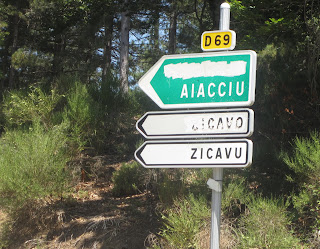If the Romans choose a place for a city, you can be sure it is the best strategic location around. So it is with Corte. On top of a hill as can be seen from the picture above, Corte is near insurmountable. The present fortifications were established by the viceroy of Aragón in 1419, and after being ruled by the Genoese and the French on and off for the next three hundred years, the city became the home of Corsican nationalism and patriotism when independence was declared here and a democratic constitution was drafted in 1735. When Corsica was liberated in 1755 by Pascal Paoli, it became the capital of Corsica and the home of its first and only university. Interestingly, the constitution gave women the right to vote. I am not sure if they ever did, but the claim of Australia and New Zealand to lead the world in women’s voting rights may be a little exaggerated.
Corte still remains the centre of the nationalist movement, but since France has been investing heavily in roads and infrastructure, the benefits of separatism are not so clear to the population at large. Still, somewhat provocatively, the French administration insists that, since Corsica is part of France, all road signs should be presented in both French and Corsican, with the French at the top. This has led to the local sport of shooting road signs – similar to the Australian country traditional pastime – but not the whole sign, only the French words. As shooting skills fall away with increased urbanisation the sport has transformed into spray painting the French signs as illustrated here:-
All very well and understandable to some extent, even after 200 years, but driving around with a French road map and trying to guess the names from the Corsican signs did prove challenging for our intrepid navigator.
If you know nothing about Corsica, and you want to do something more than get sunburned on the beaches in the south, Corte is the best place to start. The reason is the Musée Régional d'anthropologie. This museum is mainly based in the work of a monk who was sent to Corsica to teach natural history to young men in the Seminary. Father Louis Doazan took advantage of the trust afforded to a priest in this almost entirely catholic country to document the life, traditions, tools and culture of the Corsicans between 1953 and 1970. His collection is the basis of the central exhibition of the museum which provides an insight into traditional life in Corsica. Doazan then went on to work for five years with the National Museum of Popular Arts and Traditions in Paris where he chose to study pastoral farming in Corsica.
The museum has added a very well presented section on industry and economic development in the 20th Century as well as some descriptions of life and music in the cities.
Corsica made much more sense to us after a few hours at the museum.
The pictures in the link provide some views of the small (under reconstruction) roads we travelled on across the mountains, the stonework in the traditional buildings and one of the many pigs who came out to greet us on the way between Porto Vecchio and Corte.
 |
| Corte and the road |


No comments:
Post a Comment